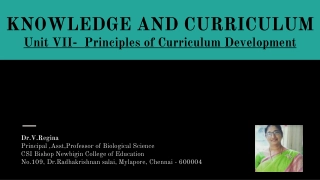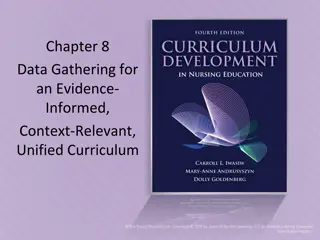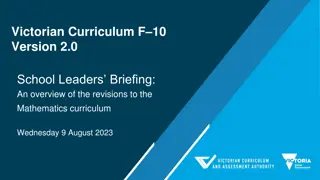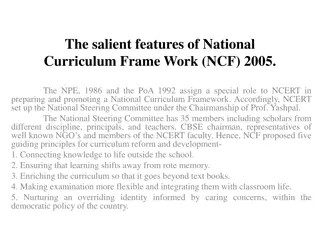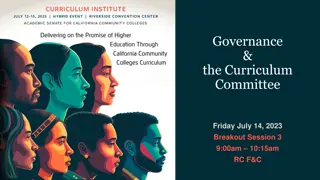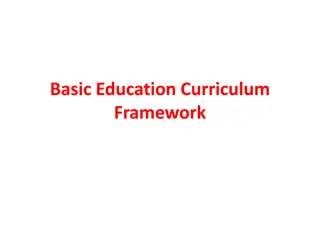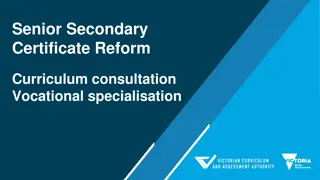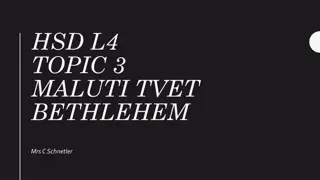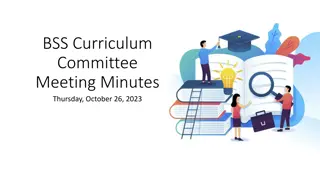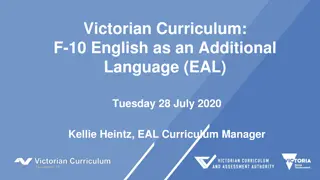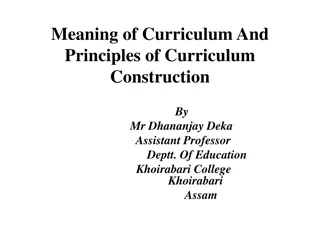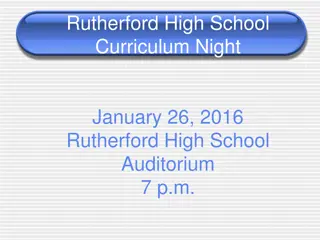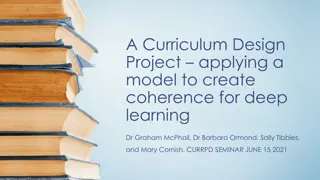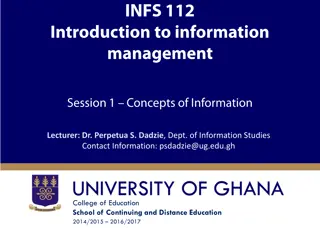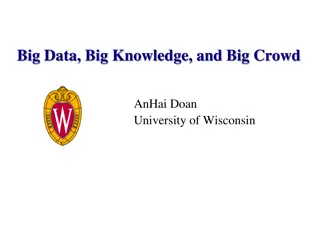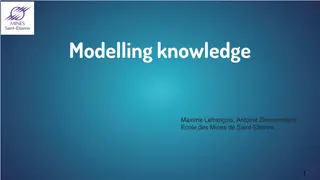Understanding Data, Information, Knowledge, and Curriculum in Education
Data is raw facts and figures, information is interpreted data with meaning, and knowledge is the accumulation of facts and information. The nature of knowledge involves acquiring information from real-life experiences and education. This content delves into the distinctions between data, information, knowledge, and the curriculum in education.
Download Presentation

Please find below an Image/Link to download the presentation.
The content on the website is provided AS IS for your information and personal use only. It may not be sold, licensed, or shared on other websites without obtaining consent from the author. Download presentation by click this link. If you encounter any issues during the download, it is possible that the publisher has removed the file from their server.
E N D
Presentation Transcript
BED202: Knowledge & Curriculum, Language across the Curriculum BED202: Unit 1Knowledge & Curriculum By: Asst.Prof. Suresh S Waghmare Dr.D.Y.Patil College of Education, Pimpri
Data Data is unprocessed facts & figures without any added interpretation or analysis. Information in raw or unorganized form (such as alphabets, numbers, or symbols) that refer to, or represent, conditions, ideas, or objects. Data is limitless and present everywhere in the universe. Data that is (1) accurate and timely, (2) specific and organized for a purpose, (3) presented within a context that gives it meaning and relevance, and (4) can lead to an increase in understanding and decrease in uncertainty. e.g The price of petrol is Rs.80 per lit.
Information Information is data that has been interpreted so that it has meaning for the user. Information is the communication or reception of knowledge or intelligence Information means knowledge investigation, study, or instruction. Information: For data to become information, it must be contextualized, categorized, condensed (Davenport & Prusak 2000). E.g. the price of petrol has risen from 80 to 85 per litre. obtained from calculated and
Characteristics of Information valuable- because it can affect behavior, a decision, or an outcome. e.g Information is a stimulus that has meaning in some context for its receiver. E.g Information reduces uncertainty. e.g Information has different meanings in different contexts. In different subjects & across different disciplines, the same word has different notions. E.g. control, data, form, education etc.
Knowledge Knowledge is Facts, information, descriptions and skills acquired through experience or education. Knowledge includes the theoretical or practical understanding of a subject. It can be implicit or explicit, it can be more or less formal or systematic. e.g. knowing the concepts of science & then learning those concepts by conducting experiment. In technical terms, knowledge is the body of truth, information, & principles acquired by humankind Knowledge is a familiarity, awareness of understanding of someone or something, such as facts, information, descriptions, or skills, which is acquired through experience or education by perceiving, discovering, or learning.
Nature of Knowledge Knowledge is the accumulation of facts & information The fact of knowing Information or what is known Whole of what can be learned or found out It is informal experience Is gained from the real life experiences Can be facts acquired from good education, peers It is gained by itself or is self driven Acquired by self efforts
Sources of knowledge Sources of knowledge Primary sources Secondary sources Historical & legal documents, eyewitness accounts, results of experiment, Statistical data, speeches, interview, survey, research articles etc Articles in newspaper, book or movie reviews, Movie
Sources of knowledge Unreliable Reliable Faith, Beliefs, Traditions, Superstations Reasoning, Sc.approach
Authority Scientific method Tradition Sources of acquiring knowledge Reasoning Experience
Steps in Scientific Approach Problem Situation Gather information Formulate Conclusion Data Formulate hypothesis analysis & hypothesis testing Conduct an experiment
Types of Knowledge Personal Knowledge: This is the kind of knowledge that we are claiming to have when we say things like I know Incidental music. The first type of knowledge is personal knowledge, or knowledge by acquaintance. Knowledge in this sense is to do with being familiar with something Procedural knowledge: The second kind of knowledge is procedural knowledge, or knowledge how to do something. People, who claim to know how to juggle, or how to drive, are not simply claiming that they understand the theory involved in those activities. Rather, they are claiming that actually possess the skills involved, that they are able to do these things. For example, driving car, how to prepare a particular dish, process of planting herbs etc.
Propositional knowledge: When we say things like I know that the internal angles of a triangle add up to 180 degrees or I know that it was you that ate my sandwich , we are claiming to have propositional knowledge.
Skill Latin word- habil-tas & refers to the skill, talent, expertise or aptitude to carry out some task. Definitions: Skill refers to the ability or proficiency to do something efficiently & completely which is acquired through training. Skill is an ability that has been acquired by training & it is the ability to produce solutions in some problem domain . For example, skill of well trained boxer, micro teaching skill
A skill is the ability to carry out a task with pre- determined results often within a given amount of time, energy, or both. Skills can often be divided into domain general and domain-specific skills. For example, in the domain of work- time management, teamwork & leadership, self motivation & others. Skill can be developed through training, practice & experience.
Types of skills Skills Verbal Numerical Hard skills Soft skills Life skills understanding
The Ten core Life Skills as laid down by WHO 1.Self-awareness 2.Empathy 3.Critical thinking 4.Creative thinking 5.Decision making 6.Problem Solving 7.Effective communication 8.Interpersonal relationship 9.Coping with stress 10.Coping with emotion
Wisdom Ability to use your knowledge and experience to make good decisions and judgments. Ability or result of an ability to think and act utilizing knowledge, experience, understanding , commonsense, and insight.
Knowledge Wisdom Meaning Knowledge is information of which someone is aware. Knowledge is really about facts & ideas that we acquire through study, research, investigation, observation or experience Wisdom is the ability to make correct judgments and decisions. It is an intangible quality gained through our experiences in life. Time Allows for change in response to new information or analyses. Seeks to always improve. Timeless. Wisdom is "Who we are" vs. "What we do" Wisdom governs choice, pursuit of knowledge, communication and relationships. Source Learning, education, science, reflection, reasoned and logical thought. Self. Intuition. Our personal experience. Wisdom defines and refines our character. "Character is simply who we are and is the persona and identity of everything we do." Approach Theoretical Spiritual
Educational Implication Make use of a variety of methods so you can make their knowledge more reliable. Make use of the variety of media so as to make teaching learning process more effective & relevant in the generation of knowledge Encourage students to actively engage themselves in the process of scientific inquiry. Give examples for enabling them to understand, comprehend, explain, analyze & predict situations.
Learning through activity: The ABL was started in Chennai in 2003, first in 13 corporation schools, then in all 264 corporation schools and in 2007 it was up scaled to nearly 37,000 schools across the state of Tamil Nadu. Its implementation has been made possible with a lot of effort and resources. The situation in which a lot of things are happening or people are moving around is called as activity. The state of being active: behavior or actions of a particular kind. Activity Based Learning - learning where student physically and mentally explore subject by simulation of the work environment, manipulation of tools and materials associated with the world of work, or performance of a real work task. Activity Based Learning (ABL) is a methodology where children of different ages are grouped together in one class and learn at their own pace through teacher-facilitated exercises. Learning through activity is based on principle learning by doing; also it is based on the theory of Constructivism. Activities provide opportunity for exploration, manipulation, search & discovery. It facilitates self learning and creativity.
Importance Passive lecture format Active learning techniques empower the learning process Visual-based learning To make each student an active player To give hands on experience
Features It uses child-friendly educational aids to foster self-learning and allows a child to study according to his/heraptitudeand skill. Learning happens through activities. Learning is contextual, so, easy to grasp and meaningful. Classroom activities are more student-centric. Application of knowledge is more important than acquiring knowledge. Knowledge is applied through various activities in this method of learning Students are not confined to their seats and classrooms. Free exchange of ideas. Children are self- motivated to know, to learn. Class rooms become a lively, interesting place. Through pair-work, group-work, whole class discussions students are exposed to a variety of view points and perspectives.
TYPES OF LEARNING ACTIVITIES Activities Social structure focused Cognitive Skill oriented Exploratory, Constructive and expressional Practical, Oral and written Individual, Pair and group
Steps in Activity based learning: Before entering in the classroom: decide the objectives, select the activities (type, time, seating arrangement etc), develop the necessary material, write necessary instructions. During the session: give clear instructions to students, monitor the students when they are doing activity, write down understanding of students using assessment. After the session: reflect what is wrong and right, why, use reflection in future planning. observations, check the
Guidelines Students are expected to be active learners Course is built upon real problems that relate to student goals and interests Some easier problems are dealt with early in the course and are used to provide paradigms and activity models Students have some flexibility in problem selection Busy work and unnecessary repetition are minimized Whenever possible, students work at own pace and on own schedule Students are encouraged / required to work together in groups and to provide suggestions, feedback, and support to one another
Organization of activities Experiencing: by giving actual experience through watching, observing, questioning, discussing, reading, drawing, calculating, playing, acting etc. Memorizing: sequencing, rearranging, differentiating, connecting with given knowledge. Understanding: Imagining, reordering, classifying, presenting in diagrammatic form, solving, predicting, evaluating etc. comparing, investigating, describing, listening, ordering, finding, restructuring,
Activities Individualized diagnosis and (some) course objectives Learning contracts Programmed learning sequences Multi-sensory instructional activities Student-designed creative activities Organize structured drills Small-group activities (in and out of class) Paired activities Design task cards Design competitive games Design problem solving games Focus on team learning/peer teaching Role play Read aloud Debates
Teachers Role Should be aware of the needs of the student in the classroom. Teacher as a planner, organizer & facilitator or guide, not an authoritarian. The teacher s role is to set tasks that help students arrive at an understanding of the concepts, Make learning challenging and motivating by selecting appropriate material, Decide teaching tools, design activities, prompt and ask questions that make learning challenging and motivating.
Students role Needs to be ready to learn Should be enthusiastic in participating in the activity Should be active & involved Requires to be prepared to think, interact, investigate, analyze & engage in problem solving
Advantages It helps to sustain interest and attention of the students It enhance creativity among students It helps to cater to the diverse needs of learner in the classroom. Activities bring variety to the process of learning. Contrast this with traditional passive listening It's easier to catch and sustain the attention and interest of the learners when they are actively involved. Students have freedom to move around. No student likes to be tied down to his bench. Learning becomes fun, an enjoyable process.
Limitations Time factor: Students can get carried away by activities. Teachers with the pressure of completing syllabus on time may find lecture method more convenient. Large classes: Teachers cannot freely move and monitor all groups and cannot provide individual attention. Passivity: Just as in traditional class rooms a few always actively participate when others remain passive listeners. Digression: Students tend to move away from the topic under discussion. It requires preparation of lot of supplementary material Requires lot of efforts
Whole brain teaching is an instructional method was developed by Chris Biffle in California in the year 1999. Whole-brain teaching is an instructional approach derived from neurolinguistic descriptions of the functions of the brain s left and right hemispheres. Whole brain teaching is an approach designed towards maximizing student engagement and focusing on the way the brain is really designed to learn. The Right Brain-Functions The Left Brain-Functions Recognizing faces Expressing emotions Music Reading emotions Color Images Intuition Creativity Verbalization of Language Logic Critical thinking Numbers Reasoning Associations
Read it fast & aloud Read it fast & aloud Red, Green, Yellow Blue, Black, Black White Orange white Brown Grey Grey Language is function of Left brain
BLUE GREEN PURPLE PINK YELLOW PINK BLUE YELLOW ORANGE RED BLACK GREEN
Whole-brain teaching is an instructional approach derived from neurolinguistic descriptions of the functions of the brain s left and right hemispheres. Whole brain teaching is an approach designed towards maximizing student engagement and focusing on the way the brain is really designed to learn. Steps: Class Yes Classroom rules Teach- ok Scoreboard game Hands & Eyes Mirror Switch
Features It combines direct instruction, sharing & immediate feedback It makes possible active engagement of every students. It brings a change from routine lecture. It is useful for any age group. It helps to maintain the classroom dynamic. It facillitates classroom management. Beneficial for strengthening retention of students. It makes possible organization of cooperative learning
Steps in Whole Brain Approach 1. Class-Yes The teacher begins class by saying Class any way he/she likes. In turn the class is responsible for mimicking the teacher s voice by responding Yes . 2. Classroom Rules Follow directions quickly! Raise your hand for permission to speak. Raise your hand to leave your seat. Make smart choices! Keep your dear teacher happy!
3. Teach- OK This is the informative part of the lesson. The teacher divides the part in two groups. Teacher begins to teach small sections of information. After teacher has finished a small portion of information, he/she instruct the class Teach and the class responds OK . The students then work in pairs assuming the roles assigned to them, thus learning from each other. The teacher observes the students to confirm their comprehension. If the students have not understood the content he/she has to repeat the process till they understand.
4. Scoreboard Game This step is based on principle of reinforcement. Aim is to keep the students motivated in learning the task. This step can be used as a part of formative assessment during the session or at the end of session in the form summative assessment. 5. Hands and Eyes This step is important for focusing on the important points which you may be emphasizing or repeating during the lesson. It is used when the teacher wants the studens to pay extra attention to what he/she saying/doing. This step is focused on planned repetition or drilling of the content.
6. Mirror Similar to the previous step this step also allows the teacher to gain control of the classroom. The students have to repeat the actions of teacher. Here the teacher contributes his/her own techniques and ideas to convey the content during the session. Students are expected to mirror the teacher. 7. Switch This step is to be used with Teach-OK step. The teacher must take care that not the same student teaches every time. In order to get all the students involved, the teacher would direct Switch . After the teacher says Switch , the students teaching would rotate.
Teachers Role Gain attention of students. Maintain clarity while giving instructions. Begin a new scoreboard everyday and provide appropriate motivation. Integrate their own teaching style and flair into the lessons. The steps are to be rotated and made to best accommodate the lesson. This is not prescribed lesson plan. Integrate different teaching skills, techniques and activities. Plan for formative and summative evaluation.
Students Role Assume and perform their roles appropriately. Follow the instructions carefully. Respond keenly to the teachers by participating wholeheartedly. Be accountable when working in pairs or groups. Show positive interdependence. Take responsibility for one s own learning.
Benefits It empower student as learners. It relaxes the students and maintains a tension free climate. It involves the students in a variety of ways. It combines direct instruction, sharing and immediate feedback. It makes possible active engagement of every student. It is beneficial for strengthening in the retention of students. It helps to carry out formative and summative evaluation.
Limitations Success depends on how effectively the students participate. Success also depends on how creatively the teachers use the different techniques and strategies. A lot depends on how deeply the students accept the different steps as a part of their learning process. It is difficult to make students active and involved in the various activities all the time.
Experiential learning Experiential learning is the process of learning through experience, and is more specifically defined as "learning through reflection on doing". Hands-on learning is a form of experiential learning but does not necessarily involve students reflecting on their product. Experiential learning is a method of educating through first-hand experience. Experiential [learning] is a philosophy and methodology in which educators purposefully engage with students in direct experience and focused reflection in order to increase knowledge, develop skills, and clarify values Skills, knowledge, and experience are acquired outside of the traditional academic classroom setting, and may include internships, studies abroad, field trips, field research, and service-learning projects. Experiential learning takes place when a person involved in an activity looks back and evaluates it, determines what was useful or important to remember, and uses this information to perform another activity.
Need & Importance Provides opportunity to construct their own meaning and understanding when placed in novel situation. Helps to deepen their knowledge by applying it in real life situations. Gives chance to develop skills through practice. Extend their learning beyond the classroom Bridges the gap between theory and practice Makes connections between formal and experimental curriculum
Principles of experiential learning: Learning by doing Learning through experience of oneself or of others Students are engaged intellectually, emotionally, socially, soulfully and/or physically. This involvement produces a perception that the learning task is authentic. Exploiting the natural potentiality of the human being to learn. Learning from ones errors and mistakes Self criticism and self evaluation
Steps of experiential learning: Experience Apply share Generalize Process
Experiencing/ Exploring doing: Do activity Sharing/ Reflection: discuss the observations with others Processing/Analyzing: reflect & analyze from your personal perspective Generalizing: connect lesson learned to life Application: transfer what was learned to similar situations For example : field trips Think-pair-repair: Jigsaw: Concept mapping:



